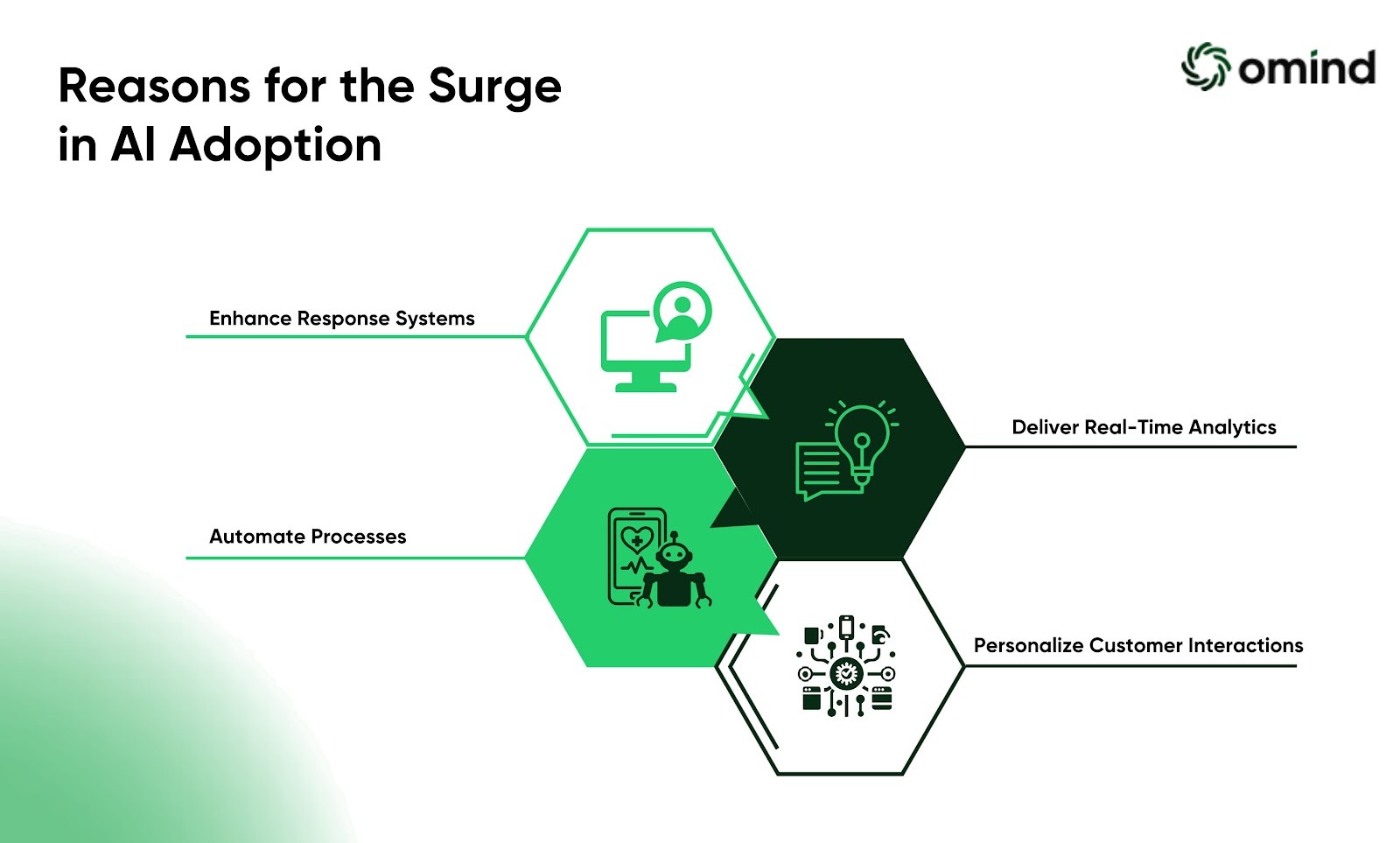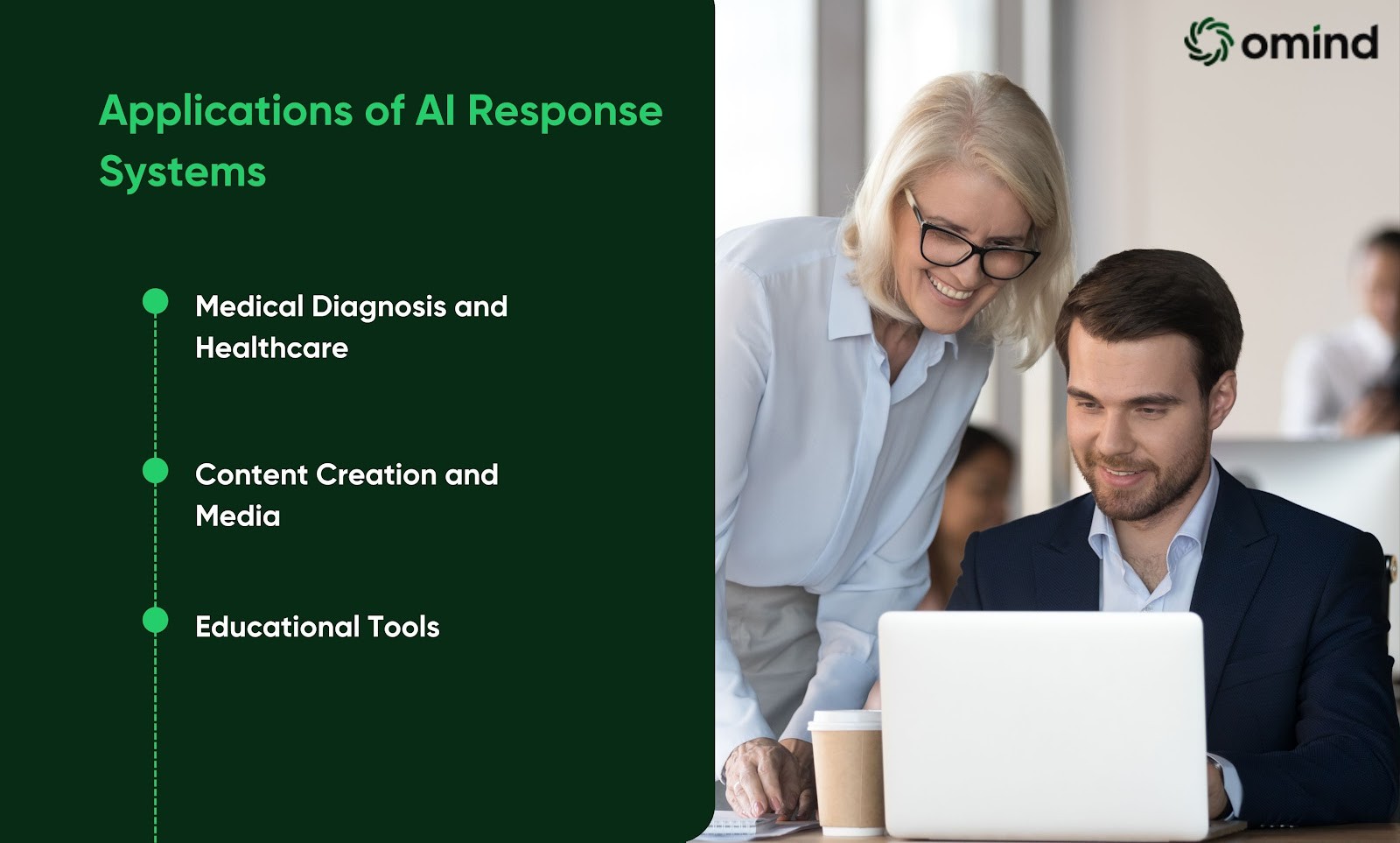In today’s tech-driven world, artificial intelligence (AI) stands as a monumental pillar that drives efficiency and innovation. As business leaders and CXOs, you must be better positioned to adapt to changing market conditions by understanding the modern applications of AI response systems.
The journey of AI began in the mid-20th century, fueled by the vision of scientists who dreamed of creating machines capable of intelligent behavior.
But today? It has come a long way, powering everything from self-driving cars to virtual assistants. The potential of AI is undeniable.
According to recently established reports, over 266 million companies are already using or exploring AI in their operations.
Reasons for the Surge in AI Adoption

Enhance Response Systems: AI-powered chatbots and virtual assistants provide instant responses to customer inquiries, improving satisfaction and efficiency.
Deliver Real-Time Analytics: AI can analyze vast amounts of data in real-time, providing actionable insights to inform decision-making.
Automate Processes: Routine tasks can be automated, freeing up human resources for more strategic work.
Personalize Customer Interactions: AI can tailor experiences to individual preferences, building stronger customer relationships.
In this blog, we'll explore how AI powers up response systems, delivering instant analytics, streamlining decision-making, and tailoring customer interactions. It’s time now to boost your operational efficiency and ensure customers are highly satisfied!
What Exactly is an AI Response System?
As AI continues to evolve, its applications will become even more diverse and sophisticated. So, an AI response system is a sophisticated technology that processes inputs from its environment and generates responses based on learned or predefined data.
For business leaders, understanding and implementing these AI response systems can result in significant strategic advantages.
Example:
Consider a scenario in which a retail CEO implements an AI system to manage customer inquiries. Previously, customer service agents spent hours responding to common questions about store hours, return policies, and product availability.
With an AI response system in place, these queries are automatically handled by the AI, which accurately pulls information from a database and crafts responses in real-time. This frees up agents to handle more complex customer needs while reducing response times and increases customer satisfaction.
Click here for more case studies on AI-integrated business solutions.
Before we dive into its types and techniques of AI response systems, let’s know more about their modern applications.
Applications of AI Response Systems

Apart from the AI-powered chatbots that handle routine customer inquiries, there are various industry-wide applications of AI response systems:
Medical Diagnosis and Healthcare: AI can assist in diagnosing diseases, analyzing medical images, and providing personalized treatment recommendations.
Content Creation and Media: AI can generate creative content, such as articles, scripts, and even music.
Educational Tools: AI-powered tutoring systems can provide personalized instruction and support to students of all ages. Recall the boom of ChatGPT, for instance.
By combining these methods and applications, AI response systems are transforming industries and improving our daily lives. From enhancing customer service to revolutionizing healthcare, AI is poised to make a significant impact on the world.
Types and Techniques of AI Response Systems
Let's explore three primary types of AI response systems to better understand their functionalities and how they can be leveraged for optimal business performance.
1. Rule-based Systems
Rule-based systems operate on a series of predefined rules. These are sets of if-then conditions that guide the system's responses to specific situations.
For instance, in customer service, a rule-based system might automatically respond to common queries like password resets or account status updates based on scripted answers. This method is straightforward and highly effective in situations where responses can be standardized.
2. Expert Systems
Expert systems mimic the decision-making ability of a human expert by applying complex rule-based algorithms to data. These systems are particularly valuable in fields like medical diagnosis, law, and finance, where they can assess vast amounts of information faster than human counterparts.
For example, in the financial sector, an expert system can analyze market conditions, past trading data, and regulatory compliance to provide investment advice or flag potential fraud.
3. Machine Learning Systems
Machine learning systems represent a more advanced type of AI that learns from past data without being explicitly programmed with rules. These systems improve over time, making them highly effective for applications requiring adaptation to new trends or patterns.
A prominent example is predictive analytics in sales and marketing.
Here, machine learning models are used to:
Forecast consumer behavior
Optimize marketing campaigns
Personalize customer interactions based on data-driven insights
By staying informed about these systems and their capabilities, you can ensure that your organization sets the benchmark for industry innovations.
And now comes the foundational technologies that make these systems effectively work!
The Building Blocks of AI Response Systems
Imagine building a robot that can understand and respond to human language. That's essentially what AI response systems do.
To achieve this, they rely on several key technologies and methods:
1. Natural Language Processing (NLP)
Think of NLP as the robot's ability to understand human language (Say conversational AI). It involves breaking down sentences into words, understanding their meaning, and interpreting the context.
NLP techniques help AI systems recognize patterns, identify keywords, and extract relevant information from text.
2. Deep Learning and Neural Networks
These are powerful machine learning techniques inspired by the human brain. Neural networks are composed of interconnected layers of artificial neurons that can learn and adapt.
Deep learning models can process large amounts of data and identify complex patterns, making them ideal for tasks like language translation and sentiment analysis.
If you are interested in incorporating Machine Learning in your retail organization, read our blog on: 10 Machine Learning Projects in Retail You Must Practice
3. Pattern Recognition
AI response systems can identify patterns and trends in data, which is crucial for understanding user behavior and preferences. By recognizing patterns, AI can anticipate user needs and provide more relevant responses.
4. Contextual Understanding
AI response systems must be able to understand the context of a conversation to provide accurate and relevant answers. This involves considering factors like:
Previous interactions
User preferences
Current topic of discussion
Are you looking to create your own AI response system? We got you covered!
Building Smarter: A Step-by-Step Guide to Designing Effective AI Response Systems

Designing an effective AI response system is crucial for leveraging AI technologies to enhance business operations and customer interactions.
Here's a straightforward guide for business leaders on how to create a robust AI response system:
Setting Clear Goals
Are you looking to improve customer service speed, enhance the quality of your customer interactions, or perhaps reduce the workload on your human staff?
Start by defining what you want your AI response system to achieve. Having specific, measurable goals will guide the development process and help ensure the system aligns with your business objectives.
Collecting and Utilizing Large Datasets
AI systems learn from data, so the quality and size of your datasets are paramount. Gather comprehensive data sets that reflect the various scenarios the AI will handle. This could be customer interaction logs, inquiry and response pairs, and other relevant data.
FYI: The more data you can provide, the better the system will perform, as it can learn and adapt from a broader array of interactions.
Balancing Automated Responses with Human Oversight
While AI response systems are remarkably capable, don't they still require a human touch to truly excel?
Design your system so that it knows when to escalate more complex or sensitive issues to human agents. This balance ensures that while your system operates efficiently, it also respects the nuances that only human judgment can provide.
Ensuring Contextual Relevance and Appropriateness
Your AI system should not only understand the questions but also the context in which they are asked. This involves programming it to recognize different types of inquiries and respond appropriately, considering the customer’s history and the specifics of their question.
Implement these steps to create an AI response system that meets the technical demands of your operations and enhances overall customer satisfaction.
Also Read: How to Utilize Artificial Intelligence in Business Operations
The Bottom Line
Businesses are on the cusp of seeing AI response systems become even more integrated and intelligent, along with enhanced NLP and predictive capabilities. To summarize, the profound impact of AI on society offers incredible benefits, such as:
Rule-based systems - Enhance efficiency by automating routine tasks
Expert systems - Augment human expertise with deep, analytical insights
Machine learning systems - Adapt and scale operations to dynamically meet customer needs and market changes
Integrating these AI response systems into your business strategy is not just an option; it's a necessity.
So, why not harness these advanced capabilities in your own operations?
Partner with Omind, the AI-fueled engine that propels businesses forward, improving efficiency and driving exceptional results across customer experiences and operational workflows.
Contact us today to schedule a demo with Omind and start transforming your productivity and operational efficiency.
AUTHOR
Team Omind
Empowering Businesses with Unified Customer Experience Platform, Leveraging Advanced AI and Intelligent Automation
PRODUCT
AI
Share LINK
Related Blogs




